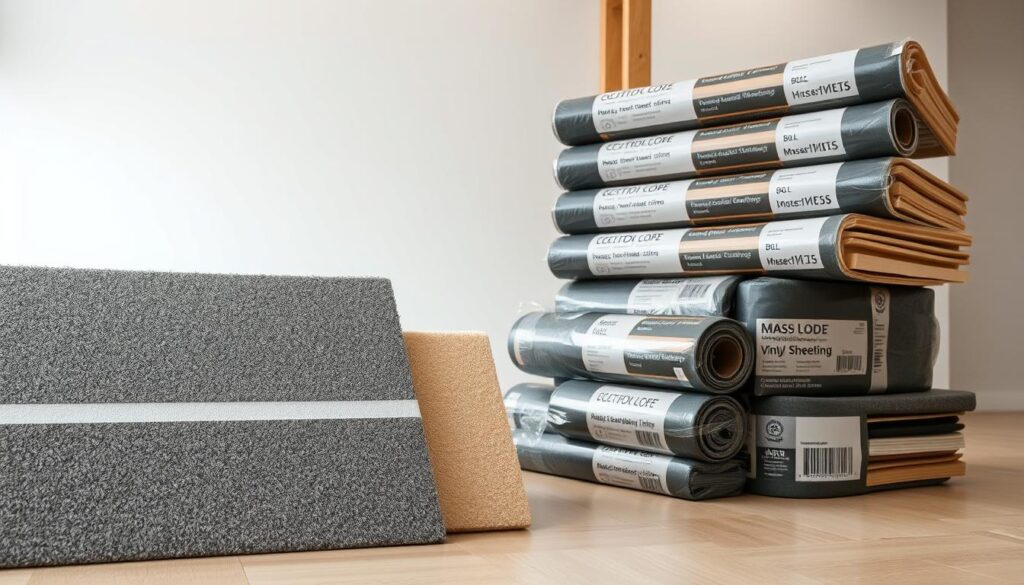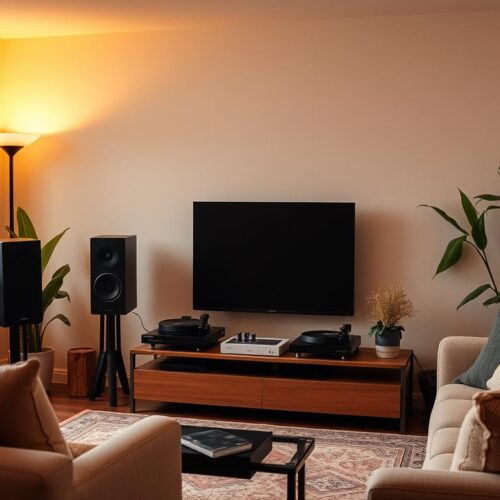Imagine coming home tired from a long day, wanting peace. But, you’re greeted by loud music or endless talking from a neighbor. This is common for people in shared buildings. Because walls can be thin, handling neighbor noise is important. You should have a calm place to relax. This guide will give you tips and insights to make your living place quiet and peaceful.
Understanding the Impact of Neighbor Noise
More than half of all Americans deal with neighbor noise multiple times each year. This is especially true in apartments with shared walls. Such noise can lead to stress, lost sleep, and a lower quality of life.
It’s key to manage indoor noise to keep the peace when living close to others. There are mainly two types of sounds:
- Airborne Noise: This includes voices, music, and TV sounds that move through the air.
- Impact Noise: This type is from footsteps, dropped items, and moving furniture that shake the building.
To reduce these noises, an effective soundproofing of apartments is crucial. It helps create a calmer home. Let’s look at common noise sources and how they affect us:
| Noise Source | Type | Potential Impact | Mitigation Strategy |
|---|---|---|---|
| Loud Music | Airborne | Disruption of concentration and sleep | Soundproof curtains, earplugs |
| Footsteps | Impact | Anxiety, stress | Carpet padding, area rugs |
| TV Noise | Airborne | Difficulty in focusing | Acoustic panels, white noise machines |
| Dropped Objects | Impact | Interrupted sleep | Furniture padding, sound-absorbing mats |
In buildings with many people, it’s important to lessen noise for everyone. Taking steps to soundproof apartments can greatly improve shared living spaces.
Recognizing Your Rights as a Resident
It’s key to know your resident rights to maintain peace where you live. Noise ordinances and your lease tell you about allowed noise levels in shared places. Loud sounds can ruin your peace and comfort. Knowing the rules about noise can really help, especially with loud footsteps, music, or people talking a lot.
One important part of resident rights is the rules about noise ordinances. These rules differ depending on where you live but aim to keep noise down. They set quiet hours and what noise level is okay, so you know when someone’s noise is too much. They’re made so everyone can have some peace and quiet.
If noise bothers you, think about making your place soundproof. This can really cut down on noise, giving you peace faster. Things like rugs, curtains, or panels that block sound can make your home much quieter.
| Noise Type | Possible Solutions | Related Resident Rights |
|---|---|---|
| Footsteps | Carpets, Rugs | Reasonable enjoyment of the apartment |
| Loud Music | Soundproof Panels | Enforcement of noise ordinances |
| Constant Chatter | Heavy Curtains | Right to peace and quiet |
Communicating with Your Neighbors
Talking well with your neighbors is key for a peaceful life together. When you handle noise complaints with care, you fix problems and get along better. This helps everyone live better together.
Pick a good time to talk, making sure it works for both of you. It’s crucial to stay calm and polite during the discussion.
- Begin with a friendly greeting to set a positive tone.
- State your concerns clearly, focusing on how the noise impacts your daily life.
- Listen actively to your neighbor’s perspective to understand their situation better.
- Propose mutually agreeable solutions to mitigate the noise issue.
Talking to neighbors does more than fix issues; it brings people closer. By encouraging open talks and understanding, we make our community safer and nicer for all.
Using Noise-Reducing Solutions in Your Space
When you want to soundproof your apartment well, choosing the right materials is key. Acoustic panels are great because they soak up sound. This stops sound from echoing off walls and ceilings.
Sealants are also widely used for soundproofing. Putting acoustic sealant around windows, doors, and wall gaps really helps. These sealants cover the small openings where noise can slip through, making a strong barrier.

For big changes, using certain building materials can make a big difference. Mass-loaded vinyl is heavy and goes behind drywall to block sound. This method cuts down on noise moving from one apartment to another.
Using a mix of soundproofing ways can work best. Like, using acoustic panels with thick rugs and curtains can really quiet things down. It makes your place more peaceful and private.
Last tip, think about how you arrange your furniture. Bookshelves full of books and soft furniture can also block sound. They help make your home quieter and calmer.
Utilizing White Noise to Drown Out Distractions
Living in a shared space means dealing with noise from outside. A good way to handle this is by using white noise machines. These tools help make your home a calmer place.
White noise makes a steady sound that hides other noises. This makes your surroundings quieter, helping you focus or relax. You can choose from different sounds, like nature or a soft fan.
Sound masking systems adjust to the noise around you. They’re great when noise levels keep changing. They help keep your space quiet, no matter what.
Using white noise or sound masking can also improve your sleep. The steady sound can help block out other noises that might keep you awake. This means you can sleep better and feel more refreshed in the morning.
Adding these tools to your home can cut down on distractions. This helps keep your living space calm and helps you stay focused.
Reporting Excessive Noise to Building Management
When you deal with ongoing noise, telling your building management is key for peace at home. It’s crucial to talk about the noise problem quickly so they can fix it. Follow these steps to help solve the issue:
- Document the Noise: Write down when and what kind of noise you hear. Also, note how long it lasts.
- Contact Building Management: Use your building’s official ways, like online, email, or a phone line, to report the noise.
- Provide Details: Giving clear information and proof of the noise will help management understand how serious it is.
- Follow Up: If nothing happens after your first report, check in with management to make sure they’re working on it.
Building management should keep where you live quiet for all. By reporting loud noise quickly and the right way, you help solve these problems. This makes sure everybody can enjoy their home without being disturbed.
Exploring Mediation Techniques
Mediation offers a neutral zone to solve noise problems. It opens up communication. In noise mediation, a mediator helps both sides talk and listen. This ensures everyone’s views are respected.
The process aims for peaceful solutions. It maintains harmony where you live. It’s not just about stopping the noise now, but how to get along later. Understanding the issue and potential fixes is key to its success.
- Requesting Mediation: Find a mediator or community services.
- Preparing for Sessions: Bring any proof of noise issues.
- Engaging in Dialogue: Talk openly but stay respectful and focus on solutions.
- Finding Compromises: Work out solutions that meet everyone’s needs.
Let’s look at what mediation can achieve:
| Outcome | Benefits |
|---|---|
| Agreed Noise Limits | Set clear noise levels to avoid future problems. |
| Soundproofing Measures | Use things like insulation or white noise to cut down noise. |
| Scheduled Quiet Hours | Agree on quiet times to keep everyone happy. |
Mediation does more than fix the issue at hand. It helps neighbors live together peacefully. It builds understanding and teamwork.
Engaging Community Resources
Handling noise issues often goes beyond just our own efforts. Getting help from community support can greatly boost your noise reduction plans. By working with local groups or services, you tap into a network ready to tackle noise problems together.
Local councils and boards have tools to assist with noise. They offer services like mediation, noise control tips, and meetings for concerned residents. Using these services not only helps with noise but also builds community unity.
Below is a list of community supports that could help with noise issues:

| Community Resource | Services Provided | Contact Information |
|---|---|---|
| Neighborhood Associations | Dispute resolution, mediation, neighborhood meetings | Local community center |
| Local Councils | Noise ordinance enforcement, complaint resolution | City Hall office |
| Community Boards | Guidelines on noise control, resident support programs | Community board website |
Using these resources means taking a team approach to reduce noise. It shows you’re eager to work together, helping solve noise problems in a friendly and effective way.
Creating Noise-Limiting Agreements
Making noise agreements is key for peaceful living in buildings with shared walls. Setting clear rules helps everyone know what’s expected. Everyone involved should help decide on the noise levels and quiet times.
To make solid noise agreements, follow these steps:
- Organize a meeting with all residents affected by shared walls.
- Discuss common noise concerns and the impact of noise on daily life.
- Draft a preliminary guideline that includes agreed noise limits and designated quiet hours.
- Consult with a legal advisor to ensure the agreement complies with local regulations and building policies.
- Obtain signatures from all participating residents, signifying their commitment to uphold the noise agreements.
- Acceptable noise levels during daytime and nighttime hours.
- Specific quiet hours, especially during evening and early morning periods.
- Restrictions on high-volume activities such as parties or home repairs.
- Resolution protocols for noise complaints.
Adding these parts makes for better living together by reducing fights. It builds a community based on respect and everyone’s right to peace at home.
Lifestyle Adjustments for Coping with Noise
Living in places like apartments means you often hear noise from neighbors. Making smart lifestyle adjustments can help you handle this. Changing how your living space is set up, tweaking daily habits, and finding coping strategies can cut down on the bother from outside noise.
First, look at how your home is arranged. Move big furniture like bookshelves against walls you share with neighbors to block sound. Putting down rugs and hanging curtains can soak up noise, making your place quieter.
Changing your routine can help too. Do loud tasks, like using the vacuum, when neighbors are likely out. Wearing noise-canceling headphones when you work or study can also make it easier to focus.
Using things that make steady sounds, like white noise machines or fans, can cover up annoying noises. Plus, plants not only make your space look better but also help swallow up sound, making your home more peaceful.
Here’s a quick summary of some changes you can make and their benefits:
| Lifestyle Adjustment | Benefit |
|---|---|
| Rearranging furniture | Enhanced noise absorption |
| Placing rugs and carpets | Reduced echo and sound amplification |
| Using noise-canceling headphones | Improved concentration |
| Incorporating plants | Natural sound absorption |
| Utilizing white noise machines | Masking disruptive sounds |
Legal Recourse for Persistent Noise Issues
If you’re facing ongoing noise problems, it’s crucial to act quickly to find a fix. But sometimes, talking it out or other simple fixes don’t work. That’s when you need to know about your legal options to defend your rights as a resident.
You might need to file a formal complaint with local authorities or a housing board. Doing this usually means you need to keep a detailed log of the noise issues and any efforts you’ve made to sort them out. Often, there’s a wait time or you need proof of many incidents to proceed.
Another road to take is going to small claims court to ask for money for the trouble the noise has caused you. Knowing your rights and the local laws on noise is very important here. Talking to a lawyer who knows about tenant issues can really help you get ready.
The table below outlines different legal recourse options and their potential outcomes:
| Legal Recourse Option | Description | Potential Outcome |
|---|---|---|
| Filing a Noise Complaint | Submit formal complaints to local authorities documenting disturbances. | Investigation and potential fines or warnings to the offending party. |
| Small Claims Court | Taking the issue to court to seek financial compensation for disturbances. | Monetary damages awarded to the complainant if successful. |
| Mediation Services | Utilizing professional mediators to negotiate a resolution between parties. | Mutually agreed upon solution without going to court. |
Considering legal action can be the right move if you’re dealing with constant noise. It’s about standing up for your rights and finding peace. Make sure you look at the situation closely and get legal advice when you need it.
Preventing Noise Problems in the Future
To avoid future noise issues, planning ahead is key. Choosing an apartment with noise reduction in mind is essential. Look for buildings with thick walls, good insulation, and smart layouts.
These features help create a quieter living space. Making sure these elements are in place from the start can prevent noise problems later.
When looking at places to live, visit them at different times. This helps you understand the usual noise levels and find out if there are noisy times. Talking to people who already live there can also give you useful information.
Pushing for better building practices can make homes quieter. You can support rules that make builders use soundproofing. Asking builders and managers to focus on noise reduction helps everyone. Taking these steps helps ensure your home is peaceful and comfortable.




